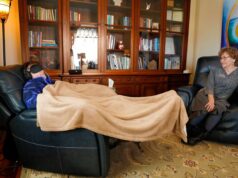

I don’t quite remember seeing my first swastika, but I do remember first realizing what it meant. Like many Jews, I felt the Holocaust sit on my consciousness and take a space in my identity. I remember listening to my mother talk about the reasons why my family would have been taken away — my two brothers were autistic, we were Jewish. My twin brother and I would be anomalies to whom someone whose name I could never remember would do something that I could never forget.
I realized what the swastika meant when I saw Captain Von Trapp rip it apart in the Sound of Music. I knew it meant something when the family was chased away from their homeland and my mother said that this is what her mother and father did. They didn’t quite hike over the Alps singing — one travelled from the Alps of Northern Italy to Quito, Ecuador, the other travelled by boat from central Italy to New York.
The next swastika I saw was written on a flier in my middle school hallway — the words “Hike-A-Thon” had been vandalized to become “Kike-A-Thon.” That’s when I learned what that word meant in the context of the little swastika drawn in pencil.
Swastikas became a little more familiar after this — casually slipping into news articles and graffiti, the “edgy” drawings on desks in high schools. The next one that stuck in my memory was on a train in Italy — exploring my Nonni’s country. I remember glancing out the window to see a swastika slip by on a brick wall. I remembered tucking in the Star of David around my neck and wondering if 70 years wasn’t as long as I had once believed.
The one that has buried itself within my thoughts and never quite leaves me alone is the swastika I saw painted on a poster of Anne Frank’s face about 10 minutes from her house in Amsterdam. This time it wasn’t alone — the text above it read “Jewish ZioNazi propaganda.”
I don’t know if I have the words now to speak about this in its entirety. Why should Anne’s face be linked to the group that killed her? Why should Jewish ever be used to describe Nazi when it is inherently a group built against them? Why should Zionism be equated to a young Jewish woman — why does your hate take its toll against the young girl when hate is the very reason she died?
These questions followed me back to the United States where just around a year later, I climbed Mount Tom for an article in The Mount Holyoke News student newspaper. I knew what I was looking for — photos for an article, maybe a couple quotes. I found swastikas sprinkled around the rocks. I stood next to rocks saying “Kill Jews” and “Gas the Jews.” I saw Hitler’s name scribbled dozens of times.
At a Shabbat dinner, I found myself talking with old and new friends for hours about the Jewish experience, be it at Mount Holyoke or our respective homes. The thing I found myself returning to most is the comment a friend made and later shared on Facebook. The crux of the argument was that swastikas continue to be shared and spread as symbols of hate, but are not labelled as Anti-Semitic. Maybe it’s assumed that the swastika is a symbol of hatred against Jews, but why do we never say this? Every article and every post I read describing swastikas as a mark of hatred against humanity — not Jews — bruises every bone in my Jewish body.
When people speak about the rise of the Neo-Nazi and fascist rhetoric or refer to Trump as Hitler without acknowledging Jewish fear, it stings. When I say that the swastika scares me as a Jew, the response should not be that the Nazis hated and persecuted many different people and minorities. You’re absolutely right, but that is something Jews don’t forget. I don’t remember the last time I spoke about the death of 6 million Jews without a non-Jewish individual immediately supplementing the other 5 million. Jews do not forget this, but it is important for us to mourn our own as well. When people tell me that the Holocaust gets too much attention while equal or worse tragedies occur everyday — I know. I know that genocides occur throughout history and my group is not alone in its suffering.
But I am not here to compare tragedies.
On top of Mount Tom, I tried to scrub away the letter ‘J’ in “Kill Jews.” I immediately grew tired when I thought I would be strong — I thought I could get rid of the entire word. But, I got stuck on ‘J’ for Jew. I will always be stuck on ‘J.’
Hannah Roach is a senior at Mount Holyoke College where she studies in Biology and English. Contact her at [email protected].








